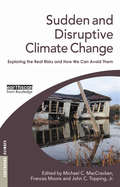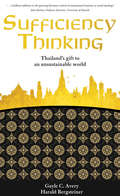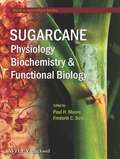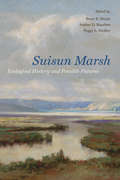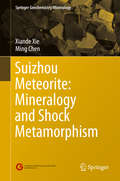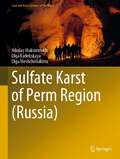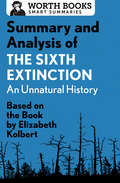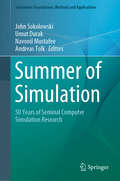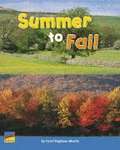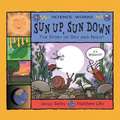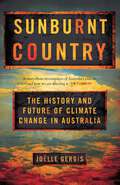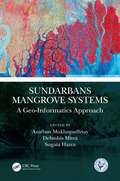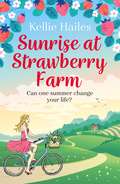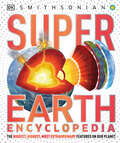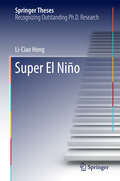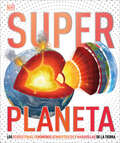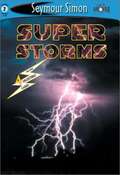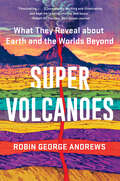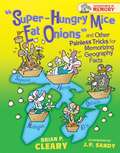- Table View
- List View
Sudden and Disruptive Climate Change: Exploring the Real Risks and How We Can Avoid Them (Earthscan Climate Ser.)
by Michael C. MacCracken Frances Moore John C. Topping'An impressive accomplishment. Al Gore, Former Vice President of the US, co-recipient of the 2007 Nobel Peace Prize, and author of An Inconvenient Truth Offers positive solutions that no rational person, organization or government can ignore - except at their peril. Stephen H. Schneider, Professor for Interdisciplinary Environmental Studies, Stanford University, and author of The Genesis Strategy: Climate and Global Survival The science is clear and the message of this book is that there is no more time for delay. Rosina M. Bierbaum, Dean, University of Michigan While changes in emissions and atmospheric concentrations of greenhouse gases are projected to be slow and smooth, the intensity and impacts of climate change on the environment and society could be abrupt and erratic. Surprising and nonlinear responses are likely to occur as warming exceeds certain thresholds, inducing relatively rapid and disruptive changes in the Greenland and West Antarctic ice sheets, precipitation intensity and patterns, coastal inundation, the occurrence of wildfire, the ranges of plant and animal species and more. Written by a transdisciplinary group of internationally respected researchers, this book explores the possibilities of such changes, their significance for society and efforts to move more rapidly to limit climate change than current government measures.
Sufficiency Thinking: Thailand's gift to an unsustainable world
by Gayle C. AveryOur world is under pressure, with growing inequalities in wealth and access to food and clean water. We depend too heavily on polluting fuels and diminishing natural resources. Traditional cultural practices are being swamped by global popular culture.The Thai model of sufficiency thinking aims to transform the mindset of a whole population to achieve the seemingly impossible: enriching everyone's lives in a truly sustainable way.Innovative management practices developed by King Bhumibol Adulyadej of Thailand have been applied across Thailand in agriculture, education, business, government and community organisations for over two decades.In this book, chapters written by eminent Thai scholars explain sufficiency thinking and review its implementation in different sectors including community development, business, agriculture, health care, schools, and even in prisons.Is Thailand unique in having discovered the holy grail of a more responsible form of capitalism? No, it is not, but it is the first country whose government has adopted this kind of thinking as national policy.'...we obviously need to revise dramatically our thinking about the outlines of a just economy and a decent society in which everyone can lead dignified lives. Sufficiency Thinking provides creative approaches to this quandary and this important volume is a brilliant addition to the growing literature critical of mainstream business-as-usual ideology.' - John Komlos, Professor Emeritus, University of Munich
Sugarcane: Physiology, Biochemistry & Functional Biology
by Paul H. Moore Frederik C. BothaPhysiology of Sugarcane looks at the development of a suite of well-established and developing biofuels derived from sugarcane and cane-based co-products, such as bagasse. Chapters provide broad-ranging coverage of sugarcane biology, biotechnological advances, and breakthroughs in production and processing techniques. This single volume resource brings together essential information to researchers and industry personnel interested in utilizing and developing new fuels and bioproducts derived from cane crops.
Suggs and the City: Journeys through Disappearing London
by SuggsRevelling in the off-beat and eccentric, Londoner Suggs takes us on a nostalgic adventure to explore the disappearing history of his extraordinary home town: from the sharp tailors of Saville Row to the sex traders of Bohemian Soho, by way of quaint and quirky habitats, brilliant but endangered boozers, unique eateries that have introduced the capital to the world's finest foods and a music scene that's dear to his heart.
Suisun Marsh
by Peter B. Moyle Peggy L. Fiedler Amber D. ManfreeOne of California's most remarkable wetlands, Suisun Marsh is the largest tidal marsh on the West Coast and a major feature of the San Francisco Estuary. This productive and unique habitat supports endemic species, is a nursery for native fishes, and is a vital link for migratory waterfowl. The 6,000-year-old marsh has been affected by human activity, and humans will continue to have significant impacts on the marsh as the sea level rises and cultural values shift in the century ahead. This study includes in-depth information about the ecological and human history of Suisun Marsh, its abiotic and biotic characteristics, agents of ecological change, and alternative futures facing this ecosystem.
Suizhou Meteorite: Mineralogy and Shock Metamorphism
by Ming Chen Xiande XieThis book introduces the unusual shock-related mineralogical features of the shocked Suizhou L6 (S5) meteorite. The olivine and pyroxene in Suizhou display a mosaic shock feature, while most of plagioclase grains have transformed to glassy maskelynite. A few of the shock-induced melt veins in the meteorite are the simplest, straightest and thinnest ones among all shock-vein-bearing meteorites, and contain the most abundant high-pressure mineral species. Among the 11 identified species, tuite, xieite, and the post-spinel CF-phase of chromite are new minerals. The meteorite experienced a peak shock pressure up to 24 GPa and temperatures of up to 1000° C. Locally developed shock veins were formed at the same pressure, but at an elevated temperature of about 2000° C that was produced by localized shear-friction stress. The rapid cooling of the extremely thin shock veins is the main reason why 11 shock-induced high-pressure mineral phases could be preserved in them so well. This book offers a helpful guide for meteoritics researchers and mineralogists and invaluable resource for specialists working in high-pressure and high-temperature mineralophysics.
Sulfate Karst of Perm Region (Cave and Karst Systems of the World)
by Nikolay Maksimovich Olga Meshcheriakova Olga KadebskayaThe book provides a characteristic of sulfate karst, the features of its distribution and development in the Perm region, based on their own research and generalization of data accumulated in recent years. An updated zoning of the territory is given, partly based on the use of GIS technologies. This book also offers a detailed description of areas with characteristics of geological and hydrogeological conditions for the development of karst and karst phenomena. Besides, it also provides a detailed description of a number of caves, information about specially protected natural areas associated with sulfate karst and new unique objects that need protection. The book describes the influence of karst on economic activity and the ecological situation.The publication is intended for geologists, geographers, ecologists, karst scientists, speleologists, local historians, teachers and students of specialties related to earth sciences, as well as a wide range of karst and cave enthusiasts.
Summary and Analysis of The Sixth Extinction: Based on the Book by Elizabeth Kolbert (Smart Summaries)
by Worth BooksSo much to read, so little time? This brief overview of The Sixth Extinction tells you what you need to know—before or after you read Elizabeth Kolbert&’s book. Crafted and edited with care, Worth Books set the standard for quality and give you the tools you need to be a well-informed reader. This short summary and analysis of The Sixth Extinction: An Unnatural History by Elizabeth Kolbert includes: Historical contextChapter-by-chapter overviewsDetailed timeline of key eventsImportant quotesFascinating triviaGlossary of termsSupporting material to enhance your understanding of the original work About The Sixth Extinction by Elizabeth Kolbert: Our planet has endured five events of mass extinction, from centuries of catastrophic heating and cooling to the asteroid that fell to earth and ended the Cretaceous Period. We are currently facing the sixth extinction, and this time the human species is to blame. Elizabeth Kolbert travels the world and meets with scientists who are grappling with the ecological outcomes of human activity. Her Pulitzer Prize–winning modern science classic tells the stories of thirteen different species that have already disappeared or are on the brink of extinction as a result of human activity. A captivating blend of research and historical anecdotes enlightens readers about the unintentional consequences of our behaviors, from climate change and global warming to invasive species and overexploitation. The summary and analysis in this ebook are intended to complement your reading experience and bring you closer to a great work of nonfiction.
Summer of Simulation: 50 Years of Seminal Computer Simulation Research (Simulation Foundations, Methods and Applications)
by Andreas Tolk Umut Durak Navonil Mustafee John SokolowskiThis book is based on the “Summer Simulation Multi-Conference” (SCSC), which has been a prominent platform for the dissemination of scholarly research in the M&S community for the last 50 years. In keeping with the conference’s seasonal title, the authors have called this half-century “the summer of simulation,” and it has led not only to simulation-based disciplines but also simulation as a discipline. This book discusses contributions from the SCSC in four sections. The first section is an introduction to the work. The second section is devoted to contributions from simulation research fellows who were associated with the SCSC, while the third section features the SCSC’s most influential contributions. Lastly, the fourth section includes contributions from the best papers in the last five years.Features:• A comprehensive volume dedicated to one of the simulation domain’s major conferences: the SCSC• Offers a scientometric analysis of the SCSC• Revisits high-impact topics from 50 years of the SCSC• Includes chapters by simulation research fellows associated with the SCSC• Presents updated best-paper contributions from the recent conferenceThis work will be of value to anyone interested in the evolution of modeling and simulation over the last fifty years. Readers will gain a perspective on what drove this evolution, and develop an understanding of the key contributions that allowed this technology to grow into its own academic discipline and profession.
Summer to Fall
by Carol Pugliano-MartinIn this book, learn about the changes that occur when summer becomes fall.
Sun in a Bottle?... Pie in the Sky!: The Wishful Thinking of Nuclear Fusion Energy
by L. J. ReindersThis book gives an accessible overview of the 70-year history of nuclear fusion research and the vain attempts to construct an energy-generating nuclear fusion reactor. It shows that even in the most optimistic scenario nuclear fusion, despite the claims of its proponents and the billions being spent on research, will not be able to make a sizable contribution to the energy mix in this century. The important consequence is that nuclear fusion will not be a factor in combating climate change, since the race for carbon-free energy will have been won or lost long before the first nuclear fusion power station comes on line.
Sun up, Sun down: The Story of Day and Night (Science Works)
by Jacqui BaileyFollows the sun from dawn to dusk to explain how light rays travel, how shadows are formed, how the moon lights up the night sky, and more.
Sunburnt Country: The History and Future of Climate Change in Australia
by Joëlle GergisWhat was Australia's climate like before official weather records began? How do scientists use tree-rings, ice cores and tropical corals to retrace the past? What do Indigenous seasonal calendars reveal? And what do settler diary entries about rainfall, droughts, bushfires and snowfalls tell us about natural climate cycles? Sunburnt Country pieces together Australia's climate history for the first time. It uncovers a continent long vulnerable to climate extremes and variability. It gives an unparalleled perspective on how human activities have altered patterns that have been with us for millions of years, and what climate change looks like in our own backyard. Sunburnt Country highlights the impact of a warming planet on Australian lifestyles and ecosystems and the power we all have to shape future life on Earth.
Sundarbans Mangrove Systems: A Geo-Informatics Approach
by Anirban Mukhopadhyay Debashis Mitra Sugata HazraSundarbans, a UNESCO heritage site, is the world’s largest single chunk of mangroves distributed on the Indian and Bangladesh coasts. The mangroves and associated ecosystems are one of the most fertile ecosystems of the earth. Sundarbans Mangrove Systems: A Geo-Informatics Approach portrays different perspectives of studying Sundarbans and mangroves using geospatial analysis. This book highlights the major issues with the Sundarbans mangrove forest, its future conservation strategies and its ecological importance using geo-informatics technology. It explains the usage of remote sensing data for providing information about the present state of mangroves and their tropic status, including assessment in terms of extent, density of community, condition, diversity, identifying potential habitats and heterogeneity. Furthermore, it discusses the use of hyperspectral remote sensing data for species level classification of mangroves, community zonation for biodiversity assessment and for preparing management plans for conservation. KEY FEATURES Exclusively covers the ecological state of Sundarbans (mangrove systems) through geo-informatic studies Describes the application of a combination of geomorphological, biogeochemical and remote sensing methods to the analysis of temporal changes Includes environmental factors affecting the health and decline of mangroves Covers biodiversity and ecological controls in mangroves ecosystems Discusses a remote sensing approach for tropical forested island and mangroves mapping This book is aimed at graduate students and researchers in environmental sciences, ecology, marine sciences, biology, geosciences and GIS/remote sensing areas.
Sunrise at Strawberry Farm: A warm-hearted and uplifting summer romance
by Kellie Hailes'Light hearted and a perfect read for a summer holiday - you can almost taste the strawberries' NetGalley reviewerFirst love can be as sweet as strawberries... Hannah Beety never thought she'd be back working at her family's strawberry farm, but when her mother falls ill, she knows it's time to go home. Returning to help in time for the summer harvest, Hannah's forced to face up to the broken hearts she left behind... After a decade, Grey Walker cannot believe that the woman he had planned to marry, start a family and live a cosy life with is back. Working side by side with Hannah as they prepare for the annual Strawberry Festival brings back all the memories of his first love he'd tried to bury. But as the summer days lengthen, could letting her in mean losing his heart, again? As delightfully delicious as strawberries and cream in the sunshine. This is the perfect summer romance to indulge in, perfect for fans of Katie Fforde, Jane Linfoot and Cressida McLaughlin.'Just what I needed to read in these strange times, light hearted, great characters and good story line. An escapism read.' NetGalley Reviewer'really lovely reading and a fabulous ending' NetGalley ReviewerReaders love Kellie Hailes's gorgeous summer romances:'Great characters, easy read, uplifting, funny, romantic and charming...the perfect summer read.' Beanie, NetGalley reviewer'Kellie Hailes knocked it out of the park.' Carrie, NetGalley reviewer'Such a sweet love story, that your heart just melts!' Debbie, NetGalley reviewer'A fun and charming read that I couldn't put down. ... I need to find more books by Kellie Hailes.' Vikkie, NetGalley reviewer
Sunrise at Strawberry Farm: A warm-hearted and uplifting summer romance
by Kellie Hailes'Light hearted and a perfect read for a summer holiday - you can almost taste the strawberries' NetGalley reviewerFirst love can be as sweet as strawberries... Hannah Beety never thought she'd be back working at her family's strawberry farm, but when her mother falls ill, she knows it's time to go home. Returning to help in time for the summer harvest, Hannah's forced to face up to the broken hearts she left behind... After a decade, Grey Walker cannot believe that the woman he had planned to marry, start a family and live a cosy life with is back. Working side by side with Hannah as they prepare for the annual Strawberry Festival brings back all the memories of his first love he'd tried to bury. But as the summer days lengthen, could letting her in mean losing his heart, again?As delightfully delicious as strawberries and cream in the sunshine. This is the perfect summer romance to indulge in, perfect for fans of Katie Fforde, Jane Linfoot and Cressida McLaughlin.'Just what I needed to read in these strange times, light hearted, great characters and good story line. An escapism read.' NetGalley Reviewer'really lovely reading and a fabulous ending' NetGalley ReviewerReaders love Kellie Hailes's gorgeous summer romances:'Great characters, easy read, uplifting, funny, romantic and charming...the perfect summer read.' Beanie, NetGalley reviewer'Kellie Hailes knocked it out of the park.' Carrie, NetGalley reviewer'Such a sweet love story, that your heart just melts!' Debbie, NetGalley reviewer'A fun and charming read that I couldn't put down. ... I need to find more books by Kellie Hailes.' Vikkie, NetGalley reviewer
Super Earth Encyclopedia (DK Super Nature Encyclopedias)
by DKThis visual encyclopedia is the ultimate page-turner, bringing our planet's most diverse and dramatic features together in spectacular style. Go on a breathtaking journey around the world. Scale the highest mountains, explore incredible weather patterns, and come face-to-face with the deadly forces of nature.Kids can explore the incredible, ever-changing features of Earth through mind-blowing photography, brand-new CGI artwork, fun facts, and stats. This fascinating reference book is sure to inspire the ecologists and scientists of tomorrow. Curious kids want to know everything about their planet. How do tornadoes form? What does the center of a volcanic eruption look like? Where is the hottest inhabited place on Earth? Investigate our world from its core to its cosmic connections when you journey through the spectacular imagery of colorful coral reefs, castle-like ice caves, and violent microbursts. This lively encyclopedia engages young readers with riveting information and eye-catching photography. Super Earth Encyclopedia will take your child on a jaw-dropping journey of discovering the most fascinating features of our planet.The Biggest, Highest, Most Extraordinary Features on Our PlanetFeel the mighty power of the highest waterfall and discover superheated water from a giant geyser. This educational book for children will ensure that you never look at the world, or its wonders, in the same way again.Inside the pages of this stunning book about Earth, you&’ll find: • Beautiful photography and CGI artworks of Earth&’s most dramatic features. • Dashboard-style fact files that provide information at a glance. • Informative, fun-to-read text that is based on the latest discoveries and scientific research. More from DK Books:There are more Super Encyclopedias to explore! Super Bug Encyclopedia gives you an unprecedented insight into the complex life of creepy crawlies, and Super Human Encyclopedia showcases from head to toe how extraordinary the human body is.
Super El Niño
by Li-Ciao HongThis book offers a new perspective on those El Niños that grow to extraordinary magnitudes, putting forward the claim that these "super El Niños" should be grouped into an isolated cluster. All known super El Niños exhibit pronounced features that are seldom seen in regular El Niños. Super El Niño events, which are marked by a highly deterministic life cycle, will dominate the Earth's climate for several years. This study identifies the pre-conditions and a booster mechanism that lead to the runaway growth of super El Niños, which is featured by the intense interaction between the anomalous circulation in middle/high latitudes and the ENSO source area. The study not only sheds new light on the fundamental mechanism of the ENSO but also contributes to improving its extended predictability.
Super Gravity Metallurgy: Separation of Valuable Component in Metallurgical Slag
by Zhancheng Guo Jintao GaoThis book introduces super gravity metallurgy in separation of valuable component in metallurgical slag. It collects the principle, apparatus and research for super gravity high-temperature metallurgy and the novel technology for selective crystallization and separation of various valuable components in different metallurgical slags by super gravity. Furthermore, the research results previously scattered in many journals and conferences worldwide are methodically edited and presented in a unified form. The book is likely to be of interest to university teachers, researchers, R&D engineers and graduate students in pyrometallurgy and extractive metallurgy who wish to explore innovative methods and technologies that lead to more efficient and environmentally sustainable utilization of metallurgical slag.
Super Planeta: Los ecosistemas, fenómenos atmosféricos y maravillas de la Tierra (DK Super Nature Encyclopedias)
by DKCon fotografía sorprendente, imágenes generadas por computadora especialmente para este libro, hechos y estadísticas increíbles, la enciclopedia 'Super Planeta' muestra las maravillas de nuestro mundo que los niños nunca han visto antes.Los niños pueden explorar 100 estructuras naturales increíbles, patrones climáticos increíbles, fenómenos oceánicos y características constantemente cambiantes de la Tierra. Pueden mirar hacia nuestro planeta desde el arriba, desde profundos subterráneos y desde la mitad de una tormenta furiosa mientras viajan por las espectaculares imágenes de arrecifes multicolores de coral, el centro de una erupción volcánica, cuevas de hielo en forma de castillo y mucho más. Los textos divertidos e informativos se basan en los últimos descubrimientos y la investigación científica, y los archivos de datos, presentados en una tabla práctica, proporcionan información de un vistazo.La enciclopedia 'Super Planeta' llevará a los niños a un viaje increíble, revelando las características dramáticas del este lugar tan especial y espectacular al que llamamos nuestro planeta, ¡la Tierra!"With mind-blowing photography, brand-new CGI artworks, and incredible facts and stats, 'Super Planeta' showcases the wonders of our world as kids have never seen them before.Kids can explore 100 amazing natural structures, incredible weather patterns, ocean phenomena, and constantly changing features of Earth. They can look down from above, from deep underground, and from the middle of a raging storm as they journey through the spectacular imagery of colorful coral reefs, the center of a volcanic eruption, castle-like ice caves, and much more. Lively and informative text is based on the latest discoveries and scientific research, and dashboard-style fact files provide information at a glance.'Super Planeta' will take kids on an amazing journey, revealing the dramatic features of the phenomenal planet we call home."
Super Polluters: Tackling the World’s Largest Sites of Climate-Disrupting Emissions (Society and the Environment)
by Wesley Longhofer Don Grant Andrew JorgensonPower plants are essential to achieving the standard of living that modern societies demand and the social and economic infrastructure on which they depend. Yet their indispensability has allowed them to evade responsibility for their vast carbon emissions. Fossil-fueled power plants are the single largest sites of anthropogenic greenhouse gases, making them one of the greatest threats to our planet’s climate. Significant as they are, we lack a comprehensive understanding of the social causes that enable power plant emissions and continue to delay their reduction.Super Polluters offers a groundbreaking global analysis of carbon pollution caused by the generation of electricity, pinpointing who bears the most responsibility for the energy sector’s vast emissions and what can be done about them. The sociologists Don Grant, Andrew Jorgenson, and Wesley Longhofer analyze a novel dataset on the carbon dioxide emissions and structural attributes of thousands of fossil-fueled power plants around the world, identifying which plants discharge the most carbon. They investigate the global, organizational, and political conditions that explain these hyper-emitting facilities’ behavior and call into question the claim that improvements in technical efficiency will always reduce emissions. Grant, Jorgenson, and Longhofer demonstrate which energy and climate policies are most effective at abating power-plant pollution, emphasizing how mobilized citizen activism shapes those outcomes. A comprehensive account of who bears the blame for our warming planet, Super Polluters points to more feasible and effective emission reduction strategies that target the world’s most profligate polluters.
Super Storms (Seemore Readers)
by Seymour SimonStorms are swift and violent changes in the weather. From lightning to blizzards, learn all about the awesome power of these amazing natural disturbances.
Super Volcanoes: What They Reveal About Earth And The Worlds Beyond
by Robin George AndrewsAn exhilarating, time-traveling journey to the solar system’s strangest and most awe-inspiring volcanoes. Volcanoes are capable of acts of pyrotechnical prowess verging on magic: they spout black magma more fluid than water, create shimmering cities of glass at the bottom of the ocean and frozen lakes of lava on the moon, and can even tip entire planets over. Between lava that melts and re-forms the landscape, and noxious volcanic gases that poison the atmosphere, volcanoes have threatened life on Earth countless times in our planet’s history. Yet despite their reputation for destruction, volcanoes are inseparable from the creation of our planet. A lively and utterly fascinating guide to these geologic wonders, Super Volcanoes revels in the incomparable power of volcanic eruptions past and present, Earthbound and otherwise—and recounts the daring and sometimes death-defying careers of the scientists who study them. Science journalist and volcanologist Robin George Andrews explores how these eruptions reveal secrets about the worlds to which they belong, describing the stunning ways in which volcanoes can sculpt the sea, land, and sky, and even influence the machinery that makes or breaks the existence of life. Walking us through the mechanics of some of the most infamous eruptions on Earth, Andrews outlines what we know about how volcanoes form, erupt, and evolve, as well as what scientists are still trying to puzzle out. How can we better predict when a deadly eruption will occur—and protect communities in the danger zone? Is Earth’s system of plate tectonics, unique in the solar system, the best way to forge a planet that supports life? And if life can survive and even thrive in Earth’s extreme volcanic environments—superhot, superacidic, and supersaline surroundings previously thought to be completely inhospitable—where else in the universe might we find it? Traveling from Hawai‘i, Yellowstone, Tanzania, and the ocean floor to the moon, Venus, and Mars, Andrews illuminates the cutting-edge discoveries and lingering scientific mysteries surrounding these phenomenal forces of nature.
Super-hungry Mice Eat Onions and Other Painless Tricks for Memorizing Geography Facts
by Brian P. ClearyHow in the world will you MEMORIZE everything you need to know for your next geography test? Brian P. Cleary can help! He's made up acronyms, poems, riddles, songs and more to help those tricky geography facts stick in your brain. And better yet, this book will give you ideas for how you can create your very own painless memory tricks.
